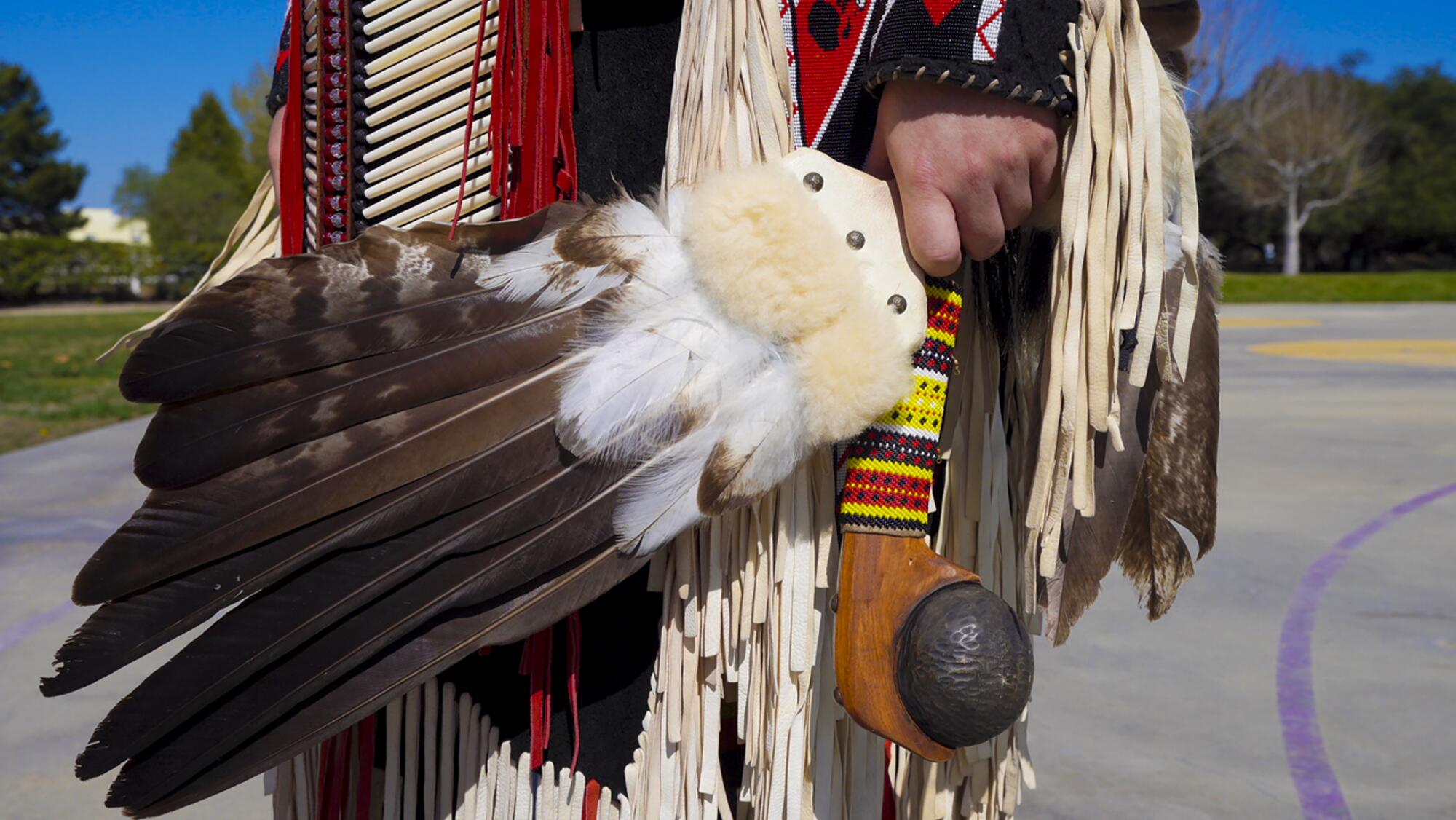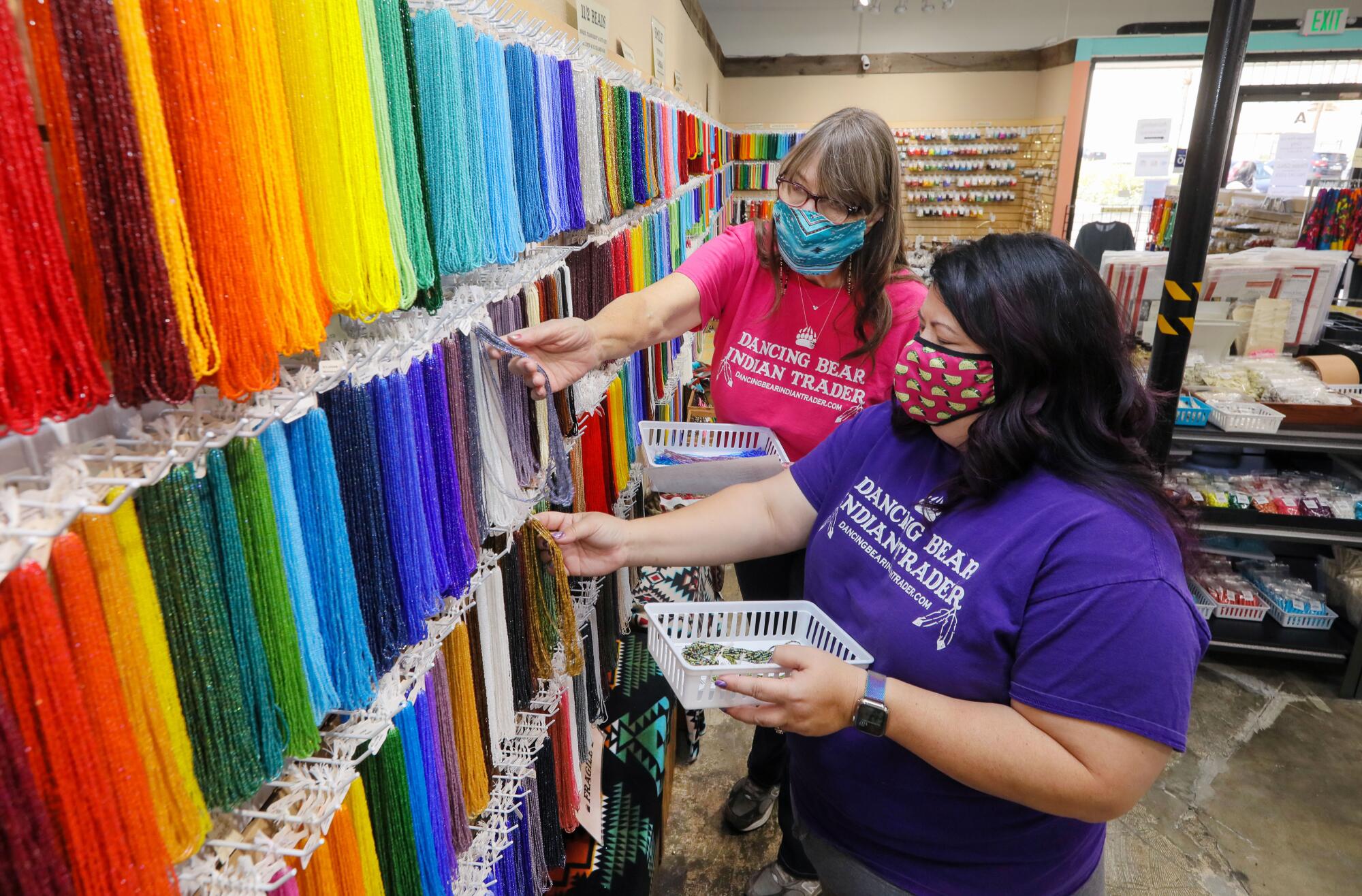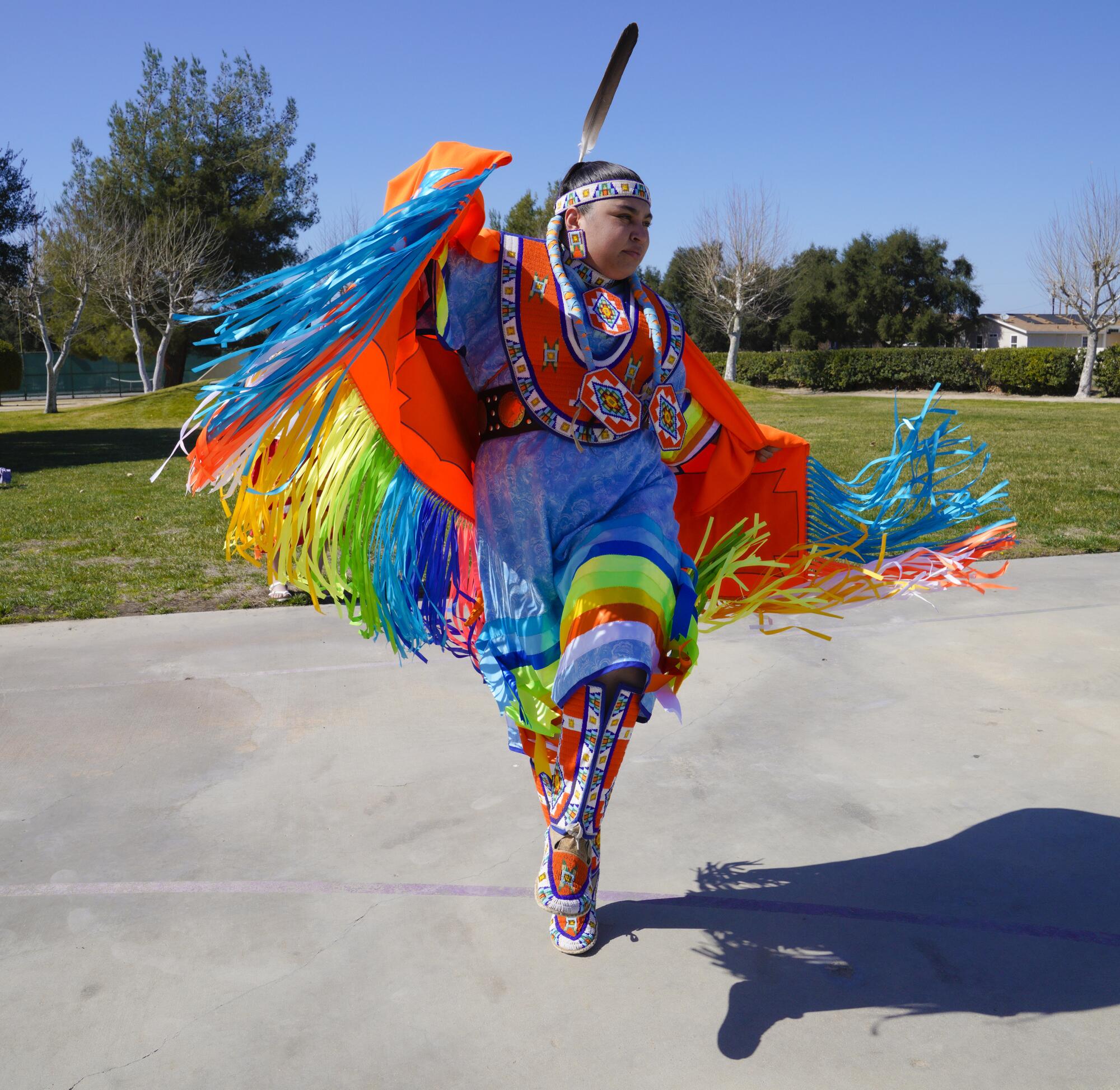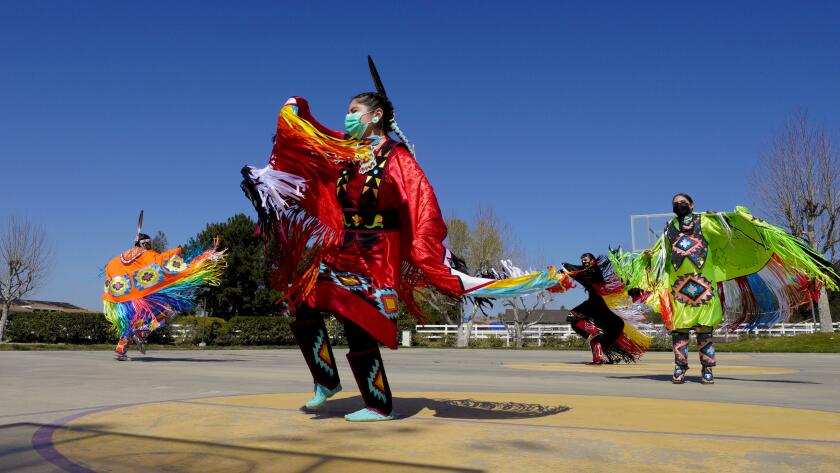- Share via
When the Fancy Moccasins met up on Feb. 27 to be photographed by the San Diego Union-Tribune, it was the first time they had all been together in a year.
- Share via
SAN DIEGO — The powwow is a celebration of life and renewal, so it’s fitting that Annalisa Berrios embraces the “fancy shawl” dance, also known as the butterfly dance because its movements re-create the moment the winged insect emerges from its cocoon.
Berrios, 33, recently felt like she, too, was emerging from a long hibernation.
For the first time since the pandemic began a year ago, she was able to gather with other dancers last month. It was a homecoming of sorts for the member of the Payómkawichum (Pechanga) Nation near Temecula.
For Berrios, the powwow circle is where she reconnects with loved ones, where she prays and strengthens her spirituality, and where she one day hopes to pass along Indigenous cultural traditions to her two sons, who at 3 and 5 are not quite ready to dance on their own.
She works for the tribe as a youth program assistant, and in her free time, she teaches other young women and girls to dance through her Fancy Moccasins Dance Organization.

After months of planning and fundraising through performances and snack bars, the group was excited about attending the world’s largest powwow last year in Albuquerque, the Gathering of Nations. It would’ve been the first time attending the event for many of the dancers, who range from 6-year-old tots to women in their 20s and 30s.
But as the COVID-19 pandemic swept across the world, the Gathering of Nations and other powwows were canceled one by one.
“It was devastating, especially to a lot of my young girls because they have never been and it was something that was always talked about within our group,” Berrios said.
It has now been a whole year without any powwows or social gatherings. And without any planned events on the horizon, many Indigenous people yearn to return to the dance circle and the community’s heartbeat: the drum, which carries the prayers of dancers and singers.
Powwows gather people from all walks of life
The COVID-19 pandemic continues to devastate and the gathering of cultures and nations throughout Indian Country has come to a halt. With a year-long cancellation of powwows comes a huge hit to the economic, health and cultural well-being to many who travel the powwow circuit.
Although many Indigenous nations claim to have held the “first powwow,” the predecessor to the modern-day, intertribal celebration is commonly thought to have started in the Great Plains during the late 1800s. As tribes were forcibly removed from their traditional homelands and confined to reservations, various nations came to meet or live closer to one another, and the inter-tribal gatherings became more prevalent.
Powwows rapidly grew in popularity after the American Indian Religious Freedom Act was enacted in 1978, which allowed Indigenous people to once again openly practice cultural, religious and spiritual traditions.
Powwows “come from the government’s outlawing of displaying Native American religion, and so all of these cultural practices weren’t allowed to happen openly and publicly,” said Chris Medellin, who is from the Tule River Yokuts Nation. Medellin is the director of the Native Resource Center at San Diego State and helps organize its annual spring powwow.
Today, Indigenous people gather for powwows throughout North America to connect with other nations; sell handmade crafts, crafting materials and traditional foods; sing and dance; and pass cultural practices from one generation to the next.
In San Diego, the celebrations draw members of the region’s 17 local tribes, those hailing from tribes in distant parts of the continent, non-native community members, and people living in both urban, rural or reservation settings.
“Modern powwows are a way to bring the entire community together,” Medellin said. “We socialize, celebrate and just basically show that our culture isn’t gone.”
Many powwow committees across the country are continuing to plan virtual events for this year, including a newly announced intercollegiate one planned by San Diego State and UC San Diego for May 1.
The economy of the powwow trail
There are many people who travel the powwow circuit from spring through late fall to earn money to care for their family’s needs. Many powwow vendors, dancers and singers travel around the country throughout the summer, using their earnings from selling their wares, playing traditional music or winning dance competitions to fund the drive to the next event.
Having a year without powwows due to the ongoing COVID-19 pandemic also means that people who depend on the powwow circuit to sustain their livelihoods have taken a major economic hit.

Chris Tracy and her daughter Svea Komori-Ang, owners of Dancing Bear Indian Trader in Escondido, have regularly traveled to powwows.
Although she was not born into an Indigenous family, Tracy started attending powwows with her friends in the 1990s and was adopted into the Cheyenne tribe by an elder in 2001.
Before the pandemic, Tracy and Komori-Ang would set up their booth at powwows to sell beads and regalia supplies every weekend in the fall and at least two powwows a month throughout the rest of the year.
It has now been more than a year since their last event in January 2020.
“Everything shut down and all the powwows fell down like a house of cards,” she said. “It was pretty scary for us because we have our store income, but it isn’t that big. We do have a website, and it all kind of adds in, but the powwows are a big part of our income, so that was a big blow.”
Others also have felt a financial loss: dancers, singers and drum groups who either compete or perform at powwows.
The Gathering of Nations attracted nearly 3,000 dancers and 91,000 spectators from around North America in 2019 and had an estimated economic impact of $22 million for Albuquerque, according to the Associated Press. Powwow organizers expected to award more than $200,000 to competitors in a variety of dance styles and age groups last year before the event was canceled. This year, it will be held virtually.
Pandemic-era cancellations affect culture, health
Training for and dancing at powwows is just one way that Indigenous youth learn about and connect with their culture. Not only does this help traditional knowledge to thrive and spread throughout communities, but it can build healthy habits such as maintaining fitness and avoiding the use of drugs and alcohol.
In 2015, researchers from the University of Washington and Alliant International University studied ways to prevent substance abuse in Native American youth populations. Through their research, they found some intervention methods were successful when they included traditional tribal activities and ceremonies, especially when those programs targeted an entire community rather than individuals.
“Most authors agree that whether a curriculum is intended to serve primarily individuals or larger groups, community support for the intervention is vital to the success of any treatment or prevention program,” the paper reads, in part.

That’s exactly what Berrios aimed to do when she launched Fancy Moccasins Dance Organization in 2009, where most of the female dancers practice fancy shawl dance.
The contemporary style was developed on the Lakota reservations of South Dakota around World War II and is primarily danced by women throughout the Indigenous, inter-tribal community, according to Tara Browner’s “Heartbeat of the People” book on powwow music and dances. Women who dance this fast-paced, high-energy style often wear brightly colored regalia with various cultural symbols or images found in nature, and wear a shawl around their back adorned with long ribbon fringe on the sides and bottom.
Fancy Moccasins was created as an extracurricular activity for Indigenous youth to stay on the traditional “red road” and avoid getting involved with drugs and alcohol. Berrios and her fellow dance instructor Kale Flores would typically meet with students twice a week, who range in age from 6 into their 20s. Most of the girls and women in the group dance fancy shawl; most of the boys and men dance a style called northern traditional.
When the group met up Feb. 27 to be photographed by the San Diego Union-Tribune, it was the first time they had all been together in a year.
“We need each other to grow, and I think not being able to get together and do that has been very hard,” Berrios said. “I’ve tried to do virtual meets with my group, and it’s just not the same. We miss that energy that we receive from one another, that hope and that good medicine feeling.”
Although many of the students have continued to avoid drug and alcohol use during the pandemic, some have started using substances to deal with the depression and loneliness caused by continued isolation. For other students, Berrios said they have been derailed at school due to the stress and boredom of distance learning.
Powwows help members pray, heal, connect with other generations
In many aspects, gathering, dancing and singing together with other Indigenous community members is a spiritual medium for prayer or a step toward healing from a traumatic event.
Dancer Ashley Jensen-Hedegaard from the Payómkawichum and Cupeño nations did not grow up dancing at powwows. But when her cousin was murdered in 2014, she learned to dance fancy shawl as a way to honor her memory and raise awareness for murdered and missing Indigenous women.
“My family went through a tragedy and we got together and we prayed,” she said. “I love going to church, I love praying, and to know that dancing is another form of prayer, it’s something I wanted to surround myself with.”

According to a 2018 report from the Urban Indian Health Institute, murder is the third-leading cause of death for Indigenous women, and the average age for victims is 29, as reflected in the limited data collected by the Department of Justice. In 2016, California had the sixth-highest number of cases for missing and murdered Indigenous women.
Like many dancers wishing to honor victims of such crimes, 29-year-old Jensen-Hedegaard’s regalia or traditional clothing is made from red cloth. Her younger cousins also joined in to learn how to dance, and together it has helped them to heal. Although it has been a difficult process to live without powwows and other gatherings over the last year, she said connecting with and watching other dancers online has helped to ease the isolation caused by the pandemic.
“Seeing other TikTok dancers and influencers helps with having a positive feed on my social media, and I still surround myself with prayer, dance and native wellness conferences via Zoom,” Jensen-Hedegaard said.
Dance can also bridge generations to one another, and as a way to pass down and preserve traditional knowledge.
When Fancy Moccasins dance instructor Flores, a 27-year-old northern traditional dancer from the Payómkawichum Nation, dances, he wears a regalia and beadwork passed down from his uncle, which all together weighs about 80 pounds. Around his neck is a beaded medallion necklace adorned with a Pechanga symbol with the nation’s sacred mountains and acorns.
When his son — who is due to be born any day now — is older, he hopes to teach him to dance and pass his uncle’s regalia down to him — along with the virtues that dance supports.
“The values of a northern traditional dancer are being a good person, having integrity, caring about your fellow native and helping when you can,” Flores said.
More to Read
Sign up for Essential California
The most important California stories and recommendations in your inbox every morning.
You may occasionally receive promotional content from the Los Angeles Times.















